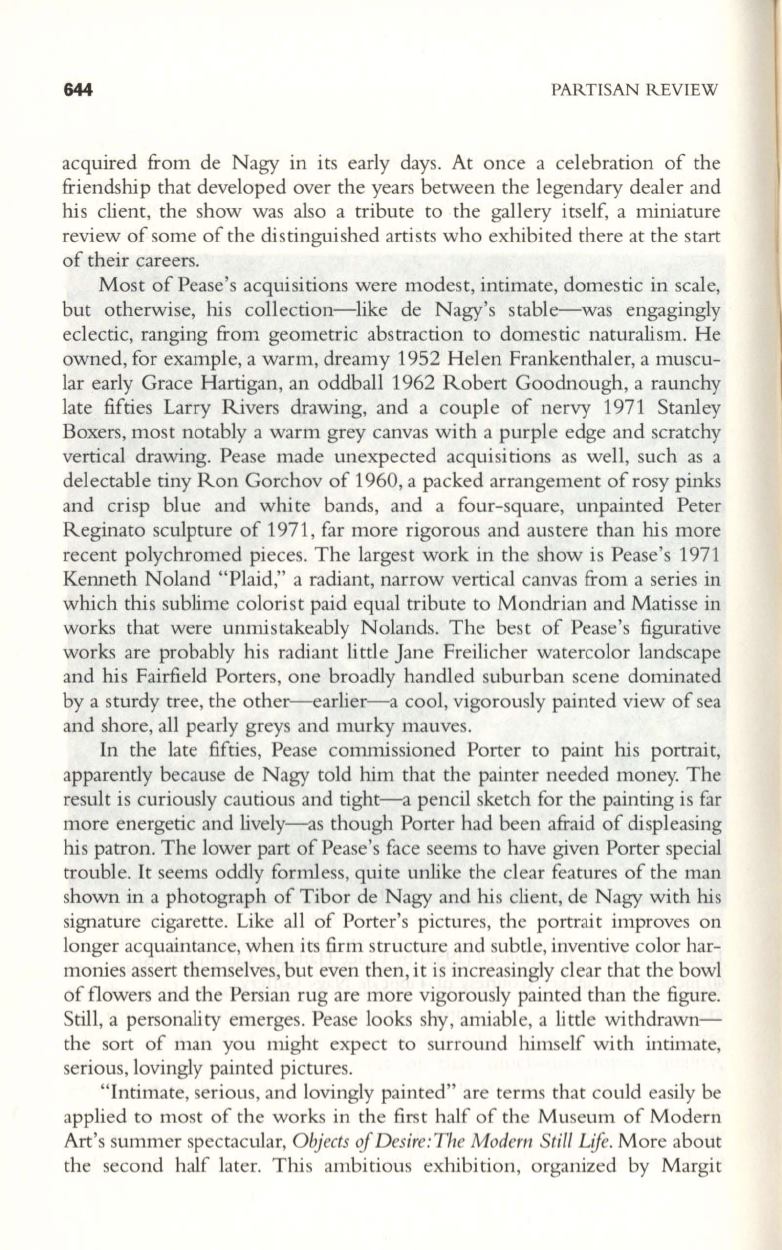
644
PARTISAN REVIEW
acquired from de Nagy in its early days. At once a celebration of the
friendship that developed over the years between the legendary dealer and
his client, the show was also a tribute
to
the gallery itself, a miniature
review of some of the distinguished artists who exhibited there at the start
of their careers.
Most of Pease's acquisitions were modest, intimate, domestic in scale,
but otherwise, his collection-like de Nagy's stable-was engagingly
eclectic, ranging from geometric abstraction to domestic naturalism. He
owned, for example, a warm, dreamy 1952 Helen Frankenthaler, a muscu–
lar early Grace Hartigan, an oddball 1962 Robert Goodnough, a raunchy
late fifties Larry Rivers drawing, and a couple of nervy 1971 Stanley
Boxers, most notably a warm grey canvas with a purple edge and scratchy
vertical drawing. Pease made unexpected acquisitions as well, such as a
delectable tiny Ron Gorchov of 1960, a packed arrangement of rosy pinks
and crisp blue and white bands, and a four-square, unpainted Peter
Reginato sculpture of 1971, far more rigorous and aus tere than his more
recent polychromed pieces. The largest work in the show is Pease's 1971
Kenneth Noland "Plaid," a radiant, narrow vertical canvas from a series in
which this sublime colorist paid equal tribute to Mondrian and Matisse in
works that were unmistakeably Nolands. The best of Pease's figurative
works are probably his radiant little Jane Freilicher watercolor landscape
and his Fairfield Porters, one broadly handled suburban scene dominated
by a sturdy tree, the other-earlier-a cool, vigorously painted view of sea
and shore, all pearly greys and murky mauves.
In the late fifties, Pease commissioned Porter to paint his portrait,
apparently because de Nagy told him that the painter needed money. The
result is curiously cautious and tight--a pencil sketch for the painting is far
more energetic and lively--as though Porter had been afraid of displeasing
his patron. The lower part of Pease's face seems to have given Porter special
trouble. It seems oddly formless, quite unlike the clear features of the man
shown in a photograph of Tibor de Nagy and his client, de Nagy with his
signature cigarette. Like all of Porter's pictures, the portrait improves on
longer acquaintance, when its firm structure and subtle, inventive color har–
monies assert themselves, but even then, it is increasingly clear that the bowl
of flowers and the Persian rug are more vigorously painted than the figure.
Still, a personality emerges. Pease looks shy, amiable, a little withdrawn–
the sort of man you might expect to surround himself with intimate,
serious, lovingly painted pictures.
"Intimate, serious, and lovingly painted" are terms that could easily be
applied to most of the works in the first half of the Museum of Modern
Art's summer spectacular,
Objects
of
Desire: The Modern Still Life.
More about
the second half later. This ambitious exhibition, organized by Margit


